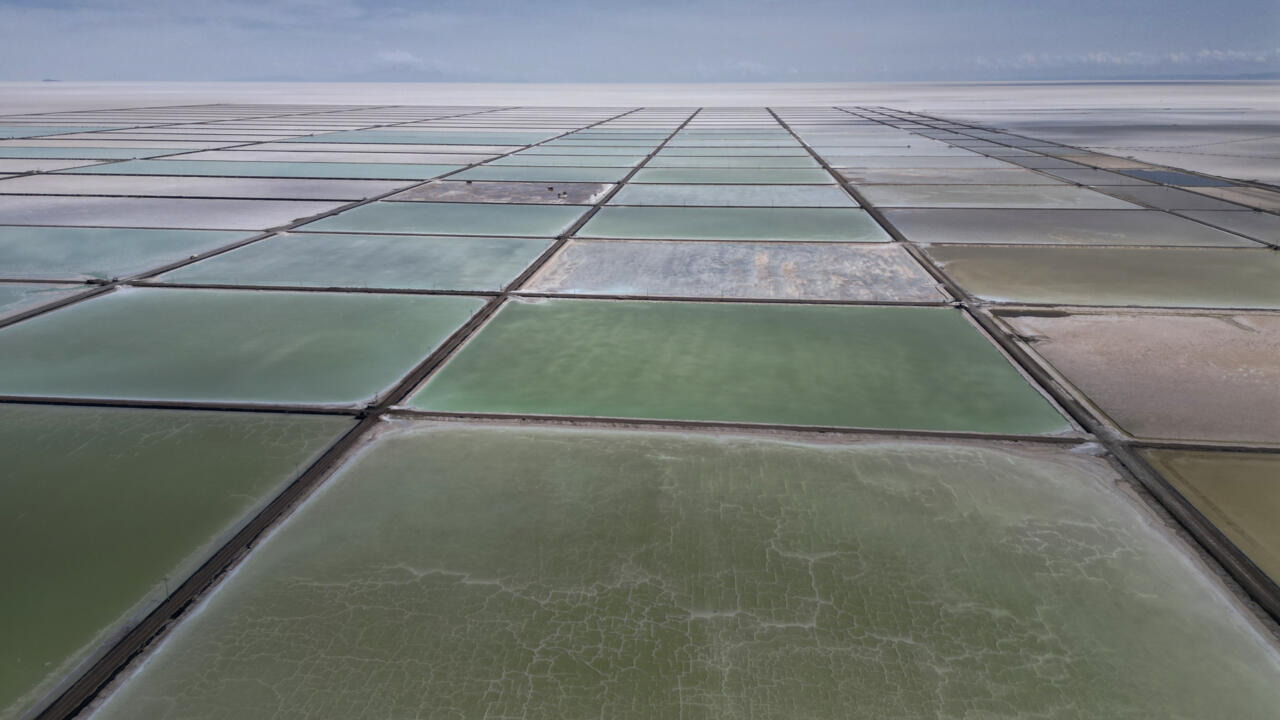 View of a plant owned by Aguas Antofagasta, a company created 20 years ago that now has three desalination plants to supply drinking water to 184,000 families in that desert city in northern Chile. Credit: Courtesy of Acades
View of a plant owned by Aguas Antofagasta, a company created 20 years ago that now has three desalination plants to supply drinking water to 184,000 families in that desert city in northern Chile. Credit: Courtesy of AcadesSANTIAGO, October 22 (IPS) - Desalination projects are booming in Chile, with 51 plants planned to process seawater and a combined investment of US$ 24.455 billion. However, these initiatives hardly benefit small-scale farmers, who are threatened by the prolonged drought, and cause environmental concerns.
A survey by the Capital Goods Corporation and the Chilean Desalination and Reuse Association (Acades) revealed that these projects, already in the engineering and construction phases, will add 39,043 liters of water per second in production capacity.
"Using seawater, desalinated or saline, and reusing wastewater relieves pressure on rivers and aquifers, ensuring water for people, ecosystems, and productive activities" –Rafael Palacios.
Fifteen of these projects belong to the mining sector, eight to the industrial sector, eight to the water utility sector, and 20 are linked to green hydrogen, a clean fuel but very water-intensive, which the country aims to be a major producer of.
Of the future plants, 17 are located in the desert region of Antofagasta, in the far north of this elongated South American country, which lies between the Andes mountain range and the Pacific Ocean.
There are 11 projects in the southern region of Magallanes, followed in number by the regions of Atacama, Coquimbo, and Valparaíso, in the north and center of Chile, which concentrate most of the investment.
Rafael Palacios, executive director of Acades, told IPS that this country “faces a scenario in which water availability in northern and central Chile could decrease by up to 50% by 2060, so we cannot continue to depend solely on continental sources.”
“Using seawater, desalinated or saline, and reusing wastewater relieves pressure on rivers and aquifers, ensuring water for people, ecosystems, and productive activities,” he emphasized.
Currently, 23 desalination plants are already operating in Chile with a capacity of 9,500 liters per second. They primarily serve mining needs, but also industrial and human consumption.
 One of the large greenhouses for the hydroponic cultivation of vegetables irrigated with desalinated water, on the farm of one of the 90 members of the Association of Agricultural Producers of Altos de la Portada, in the northern Chilean region of Antofagasta. Credit: Courtesy of the Association of Agricultural Producers of Altos de la Portada.
One of the large greenhouses for the hydroponic cultivation of vegetables irrigated with desalinated water, on the farm of one of the 90 members of the Association of Agricultural Producers of Altos de la Portada, in the northern Chilean region of Antofagasta. Credit: Courtesy of the Association of Agricultural Producers of Altos de la Portada.Small-scale farmers benefit
Dolores Jiménez has been president for the last eight years of the Association of Agricultural Producers of Altos de la Portada, in Antofagasta. The association has 90 active members who collectively own 100 hectares where they have created a Hydroponic City.
“We have no water problems thanks to an agreement with Aguas Antofagasta. We have an oasis which we would otherwise not have without that agreement,” Jiménez told IPS by telephone from Antofagasta, the capital of the region of the same name.
Aguas Antofagasta is a private company that desalinates water in the north of this country of 19.7 million inhabitants. The company draws water from the Pacific Ocean using an outfall that extends 600 meters offshore to a depth of 25 meters.
In desalination, outfalls are the underwater pipes that draw seawater and return and disperse the brine in a controlled manner, far from the coast and at an adequate depth.
Founded 20 years ago, the company currently desalinates water in three plants in the municipalities of Antofagasta, Tocopilla, and Tal Tal, supplying 184,000 families in that region.
 Dolores Jiménez, president of the Association of Agricultural Producers of Altos de la Portada, shows the strength of the crops thanks to the use of desalinated water that reaches small farmers due to an agreement with Aguas Antofagasta. Credit: Courtesy of the Association of Agricultural Producers of Altos de la Portada
Dolores Jiménez, president of the Association of Agricultural Producers of Altos de la Portada, shows the strength of the crops thanks to the use of desalinated water that reaches small farmers due to an agreement with Aguas Antofagasta. Credit: Courtesy of the Association of Agricultural Producers of Altos de la PortadaIn its project to supply the general population, it included the association of small-scale farmers who grow carrots, broccoli, Italian zucchini, cucumbers, medicinal herbs, and edible flowers.
“They support us with water from the pipeline that goes to Mejillones (a coastal city in the region). They financed the connection for us to fill six 30,000 liter tanks, installed on a plot at the highest point. From there, we distribute it using a water tanker truck,” informed Jiménez.
“Now, thanks to a project by the (state) National Irrigation Commission, we were able to secure 280 million pesos (US$294,000) for an inter-farm connection that will deliver water through pipes to 70 plots,” she added.
This will mean significant savings for the farmers.
 Jesús Basáez in his farm in Pullally, on the central coast of Chile. There he grows quinoa, which he irrigates with highly saline water that the grain tolerates without problems. Previously, that saline water forced him to stop producing strawberries. Credit: Orlando Milesi / IPS
Jesús Basáez in his farm in Pullally, on the central coast of Chile. There he grows quinoa, which he irrigates with highly saline water that the grain tolerates without problems. Previously, that saline water forced him to stop producing strawberries. Credit: Orlando Milesi / IPSIn Pullally, in the municipality of Papudo, in the central Valparaíso region, 155 kilometers northwest of Santiago, Jesús Basáez used to grow strawberries alongside a dozen other small farmers. But the crop failed due to the salinity of the groundwater, apparently caused by the drought affecting the La Ligua and Petorca rivers and proximity to the sea.
He then switched to quinoa, which tolerates salinity well. Today he is known as the King of Quinoa, a grain valued for its nutritional properties and versatility, which was an ancestral food of Andean highland peoples and has now spread among small Chilean farmers.
Basáez has three hectares planted with white, red, and black varieties of quinoa, which he irrigates with water obtained from a well, as he told IPS during a visit to his farm.
The public University of Playa Ancha, based in the city of Valparaíso, installed a mobile desalination plant on his farm that uses reverse osmosis to remove components from the saltwater that are harmful for irrigation. Pressure is applied to the saltwater so that it passes through a semipermeable membrane that filters the water, separating the salts.
After successful tests, Basáez is now about to resume his strawberry cultivation.
“It was three years of research, and it was concluded that it is viable to produce non-brackish water to grow strawberries again. The problem is that the cost remains very high and prevents replicating this experience for other farmers,” he said. The mobile plant cost the equivalent of US$ 84,000.
 The mobile desalination plant installed on Jesús Basáez’s farm to research the high salinity of the water at the site. For three years, teachers and students from the University of Playa Ancha, in the central Chilean region of Valparaíso, researched how to reduce the water salinity on this agricultural property. Credit: Orlando Milesi / IPS
The mobile desalination plant installed on Jesús Basáez’s farm to research the high salinity of the water at the site. For three years, teachers and students from the University of Playa Ancha, in the central Chilean region of Valparaíso, researched how to reduce the water salinity on this agricultural property. Credit: Orlando Milesi / IPSDebating the effects of desalination
Since 2010, Chile has been facing a long drought with water deficits of around 30%. There was extreme drought in 2019 and 2021, and the country benefited from a normal period in 2024, although the resource deficit persists, in a country where water management is also privatized.
A report from the Climate and Resilience Center of the public University of Chile, known as CR2, indicated that current rates of groundwater use are higher than the recharge capacity of the aquifers, causing a decline in reserves.
In the 23 already operational desalination plants, seawater is extracted using outfalls that are not very long, installed along the coastline of a shore that has numerous concessions and uses dedicated to aquaculture, artisanal fishermen, and indigenous communities.
The main problem is the discharge of brine following the industrial desalination process.
“I will never be against obtaining water for human consumption. Although this highly concentrated brine that goes to the seabed has an impact where a large part of our benthic resources (organisms from the bottom of water bodies) are located. On a local scale, except in the discharge area, this impact has never been evaluated,” Laura Farías, a researcher at the public University of Concepción and at CR2, told IPS.
“There is literature that points out that there is undoubtedly an impact. There are different stages of biological cycles, from larvae to settled organisms. There is even an impact on pelagic organisms that have the ability to move. And also an impact at the ecosystem level,” the academic specified by telephone from Concepción, a city in central Chile.
She added that this impact is proportional to the volume of desalinated water.
 Jesús Basáez, in the municipality of Papudo, poses showing a mature quinoa plant in one hand and in the other a container designed to sell each kilogram of the grain he produces in its white, red, and black varieties. Credit: Orlando Milesi / IPS
Jesús Basáez, in the municipality of Papudo, poses showing a mature quinoa plant in one hand and in the other a container designed to sell each kilogram of the grain he produces in its white, red, and black varieties. Credit: Orlando Milesi / IPSAccording to Farías, the water crisis has led to desalination being part of the solution, despite its impact on marine ecosystems, coastal vegetation, and wildlife.
“It is a maladaptation, because in the end it will have impacts that will affect the coastal inhabitants who depend on those resources,” she emphasized.
There are currently initiatives to legislate on the use of the coastal zone, but according to Farías, they seek to “normalize, regularize, and standardize those impacts, after these plants already exist and there are others seeking approval.”
Palacios, the director of Acades, has a different opinion.
The concerns about the environmental impact of desalination on coastal ecosystems are legitimate, but current evidence and technology demonstrate that this impact can be managed effectively, he says.
“In Chile, recent studies show no evidence that the operation of desalination plants has so far caused significant environmental impacts, thanks to constant monitoring and advanced diffusion systems,” he detailed.
He added that “in most cases, the natural salinity concentration is restored within two or three seconds and at less than 20 meters from the outfalls.”
Palacios explained that research by the Environmental Hub of the University of Playa Ancha “confirms increases in salinity of less than 5% within 100 meters.” And in areas like Caldera, a coastal city in the northern Atacama region, they are “less than 3% within 50 meters, limiting the areas of influence to small zones.”
“We are already implementing the first Clean Production Agreement in desalination and water reuse, promoted together with the (state) Agency for Sustainability and Climate Change, advancing towards voluntary standards for sustainable management, transparency, and strengthening the link with communities,” he emphasized.
© Inter Press Service (20251022001453) — All Rights Reserved. Original source: Inter Press Service

 9 hours ago
1
9 hours ago
1










 English (US) ·
English (US) ·